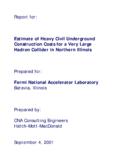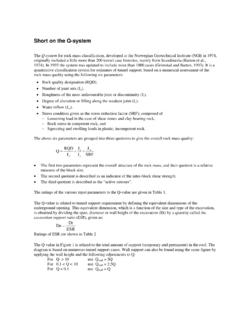Transcription of Hot Smoke Testing and Australian Standard AS4391
1 4/35 Limestone Street Darra 4076 Australia 17th February 2015 Stacey Agnew Pty. Ltd., ABN: 35 140 671 370 Tel: +61 7 30776770 Hot Smoke Testing and Australian Standard AS4391 Thoughts of Stacey Agnew as at February 2015 INTRODUCTION As fire and ventilation engineers, we have been involved in hot Smoke tests for several years. Since 2010, we have built our own capability in hot Smoke Testing , starting with methylated spirit pans and moving on to what we see as improved techniques. We are focussed primarily on tunnels and underground transportation stations.
2 For those applications particularly, it is apparent to us that the Australian Standard for Hot Smoke Testing ( AS4391 :1999) is not particularly relevant in its current form and that there are more convenient and safer alternatives for meeting typical commissioning objectives. We record our thoughts on that here and invite anyone with strong opinions on the matter to contact us with a view to making a coherent representation to Standards Australia on amending or replacing the Standard , specifically for tunnels and stations.
3 Our prime criticism of AS4391 is that it is more in the nature of a prescriptive recipe than a statement of the minimum or desirable requirements for a satisfactory test. While there is some good information on one type of test, it is the narrow specification of just one test type that is the problem. Rather than just providing a basis for test design and outcomes, it is more in the nature of an organisation s internal documentation on test procedure development. APPLICATION AND OBJECTIVES The AS4391 commentary on its application is relatively clear: The key in that extract is the statement that the intention of an AS4391 test is to verify the performance of a Smoke management system, among other design aspects.
4 For most structures it is just not possible to do that at anywhere near the designed peak heat release rate. This is particularly true for major underground infrastructure, especially vehicle tunnels, which have large design fires. For real fires in buildings or tunnels, the Smoke generation rate will be much greater than can realistically be produced as test Smoke . This is simply because the real fire plume is driven by much more heat. That is OK, as the purpose of the test Smoke is to show where the plume goes, not to reproduce the same obscuration.
5 The test Smoke is hot rather than cold so that it has buoyancy and will follow the same paths that Smoke from an unplanned fire would follow. AS4391 prescribes one type of test fire which, in the absence of wind, could give calibrated plume entrainment and heat release rates. It could be used as a repeatable methodology for generating a flow of Smoke at a known rate and temperature under ideal no-wind conditions. In that respect, it could be argued that AS4391 provides an appropriate methodology for assessing Standard building Page 2 of 7 compartments where there is no significant wind and the balance between Smoke generation and extraction is important.
6 Before we would use it for that purpose, we would want to do some verification. The plume mass flow equation in Appendix A of AS4391 seems to have the temperature ratio upside down. It doesn t seem plausible that for the same fire perimeter, a hotter flame (higher fire power) produces less plume mass flow. In a relatively straight tunnel with no underground intersections, the behaviour of lukewarm Smoke with a given tunnel airflow is pretty well known beforehand. The Smoke is then only a visual demonstration that the airflow is achieved.
7 That demonstration can be done, less visually, with an anemometer on a pole, aided perhaps by a stick with a ribbon tied to it. We have found that Smoke Testing can be very informative in unusual geometries, such as tight radius tunnel curves, changes in cross section, or merge and diverge caverns. It allows flow recirculation and vorticity to be seen. The control of overshoot when local extraction is used can also be demonstrated beneficially, although flow measurement on both sides of the extraction point is also pretty conclusive.
8 Since the test fire is very much smaller than the design fire, the dependence of Smoke control on tunnel grade in straight tunnels cannot be tested realistically. This means that repeating tests at several locations where the only difference is grade is not informative. It is clear that low heat release rate Smoke tests are only warranted in tunnels when there is a need to visualise some unusual aerodynamic aspect of the tunnel where the outcome can t readily be checked more simply. HEAT GENERATION FOR TUNNEL Testing The two essential ingredients of a hot Smoke test are, not surprisingly, heat and Smoke .
9 We look first at the heat. For flow visualisation it matters not whether the heat is generated by burning methylated spirits, LPG, diesel or gum leaves, or by focussing a giant solar collector. AS 4391 is focussed solely on methylated spirits pans as the heat source. We prefer LPG for the following reasons. We have never seen a metho test aborted or cut short, but using a hose reel to spray enough to dilute 96 L of metho ( MW test) would not be fast, without blasting the metho out of the pans.
10 Then there is the issue of disposing of up to 300 L of water-metho solution before the next test. We have aborted an LPG-fuelled test just after ignition. When the witnesses wanted more time to discuss matters, it was just a matter of signalling to the burner operator and the test was stopped in a couple of seconds with no waste. Of course it was also ready to restart immediately when everyone was ready for the test to run. Why would you not allow that convenience in a Standard ? While we do not suggest that the metho tests cannot be conducted safely, it seems to us that, with a large flame, the ability to extinguish the flame in seconds has safety benefits, for people and tunnel fittings, over a method that requires a manual fire suppression effort.







